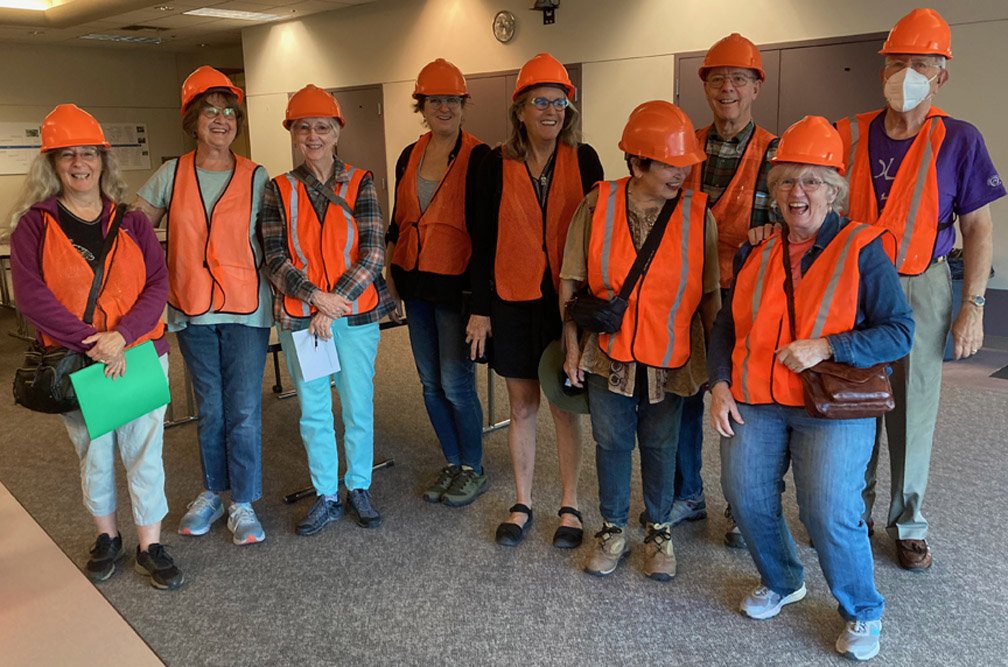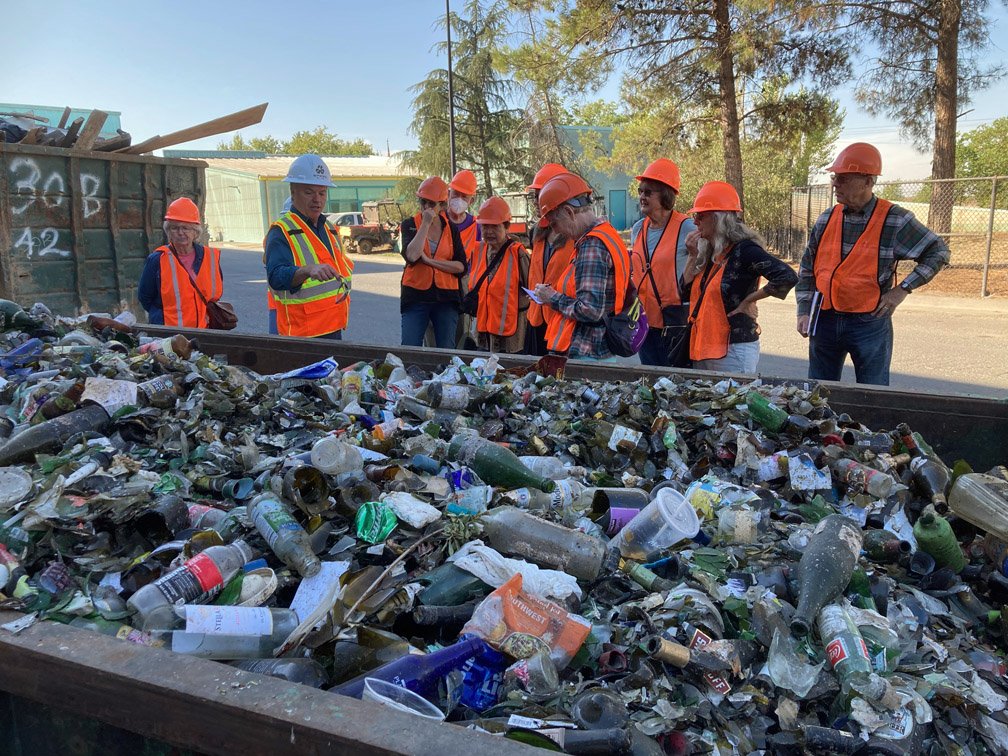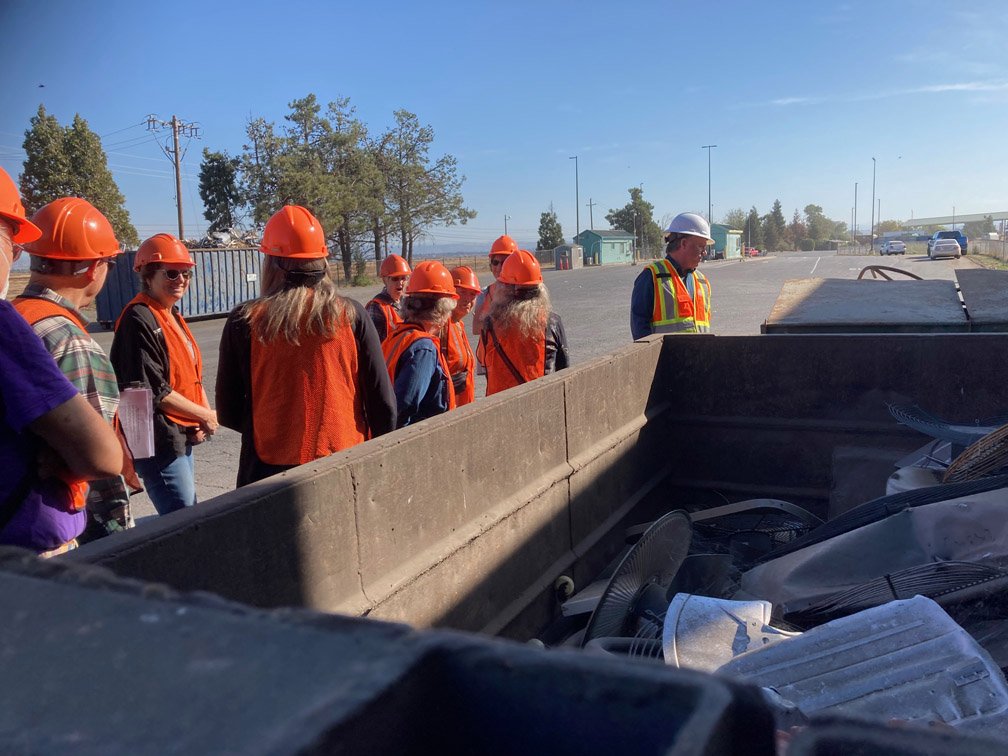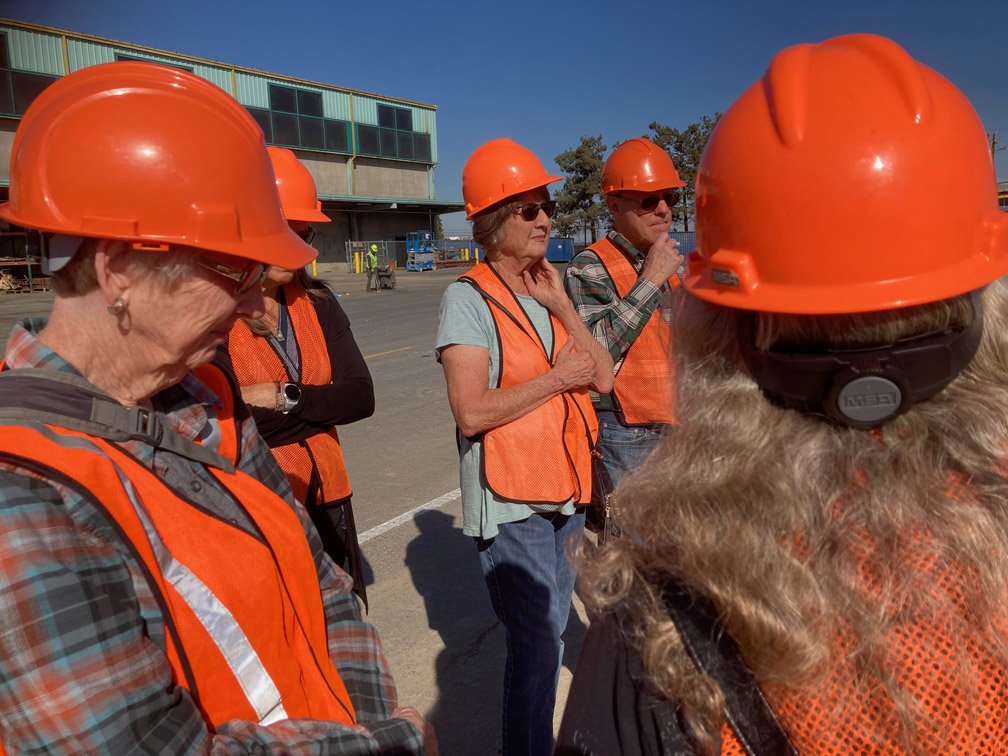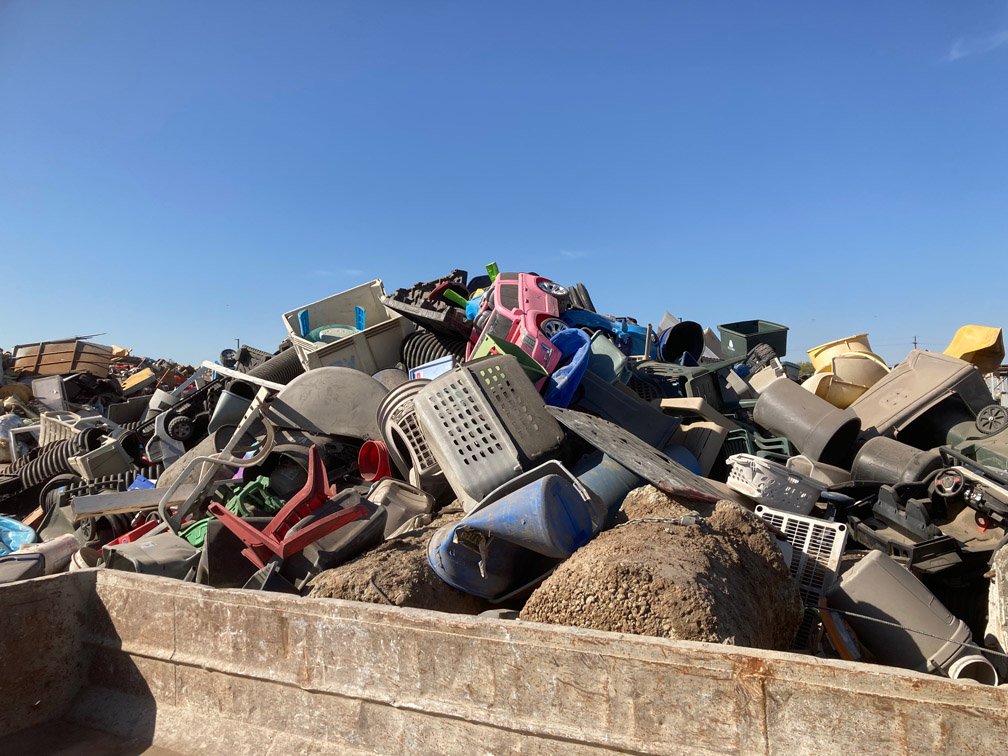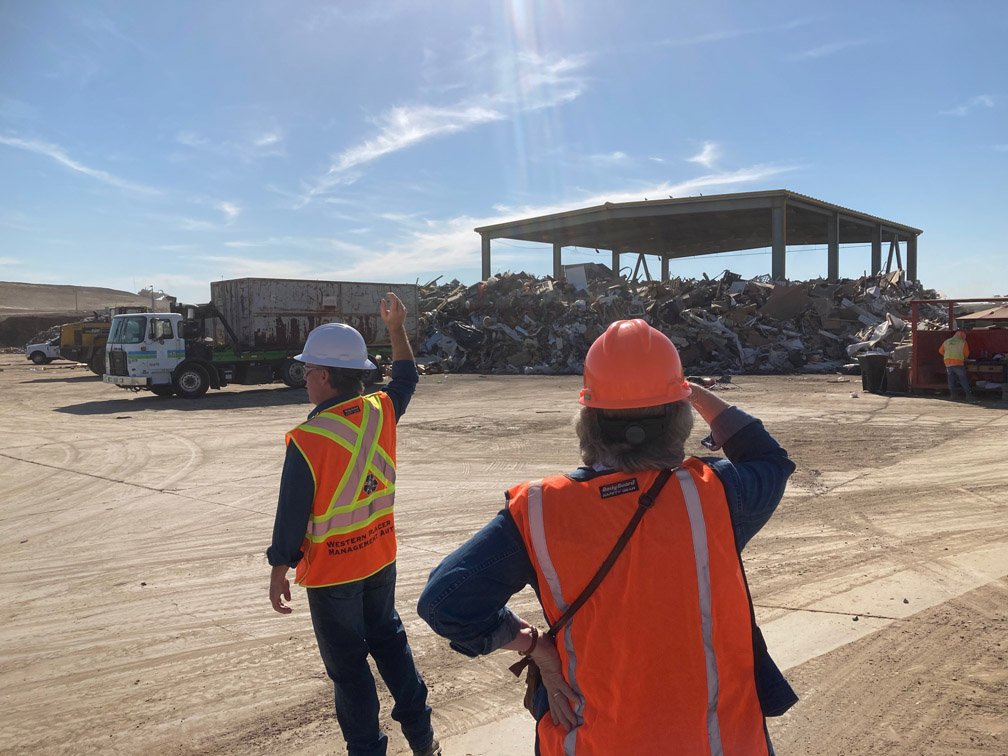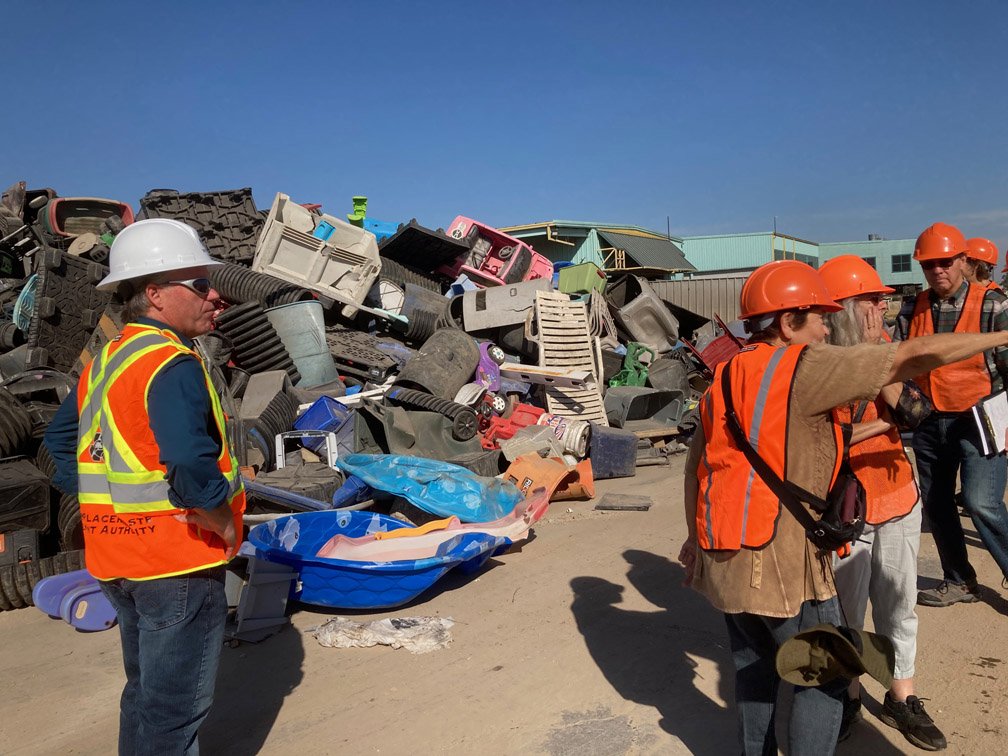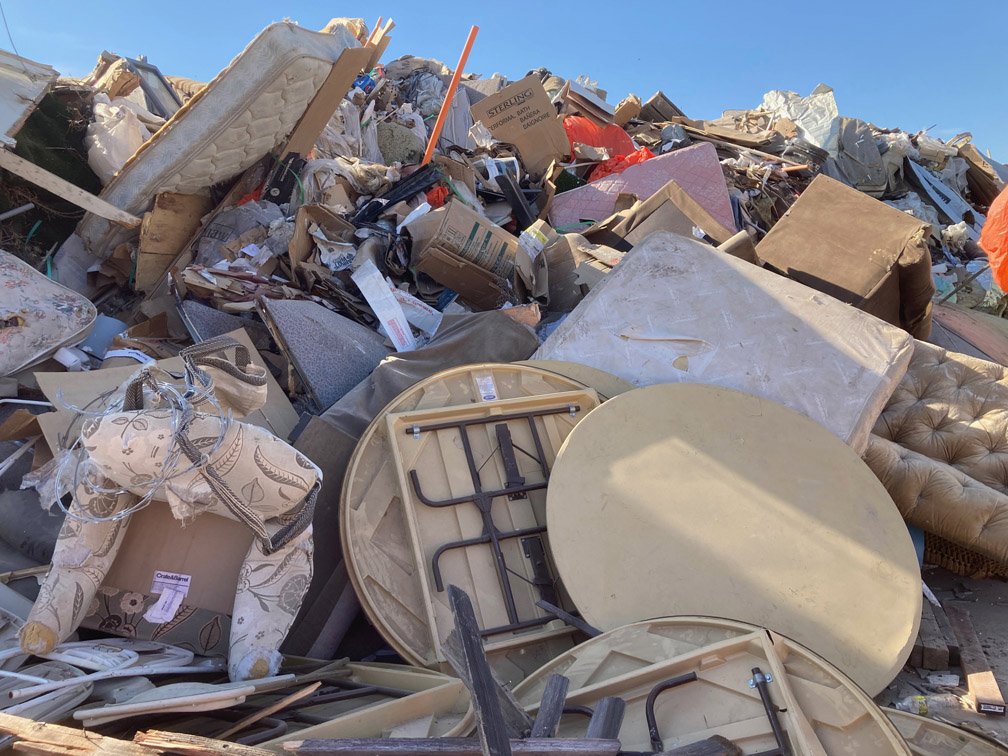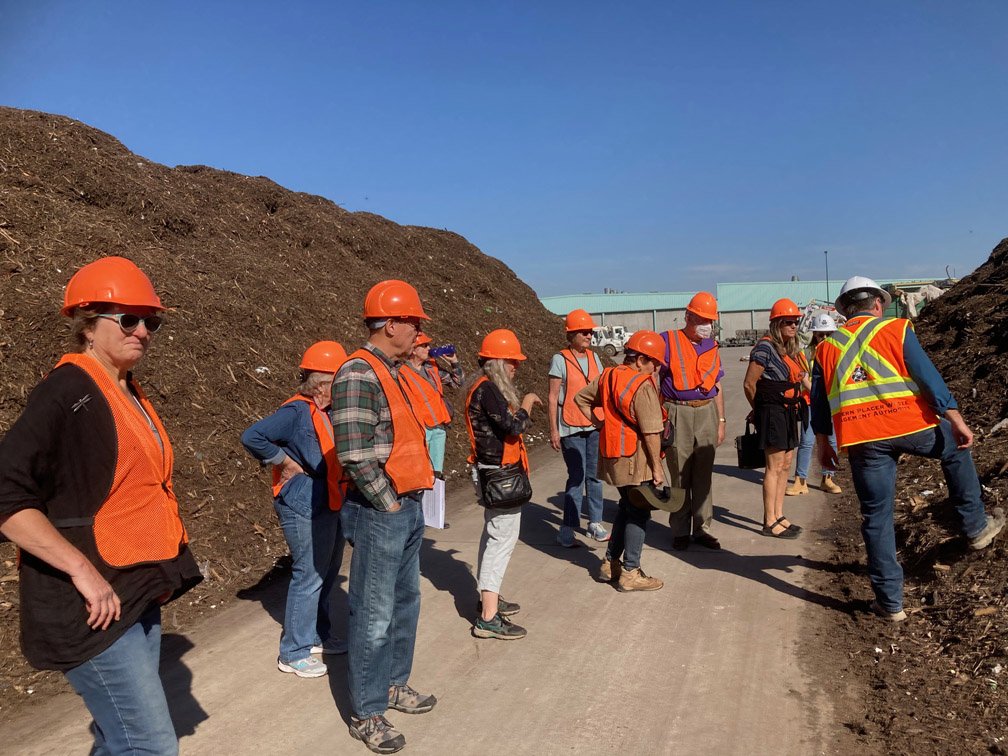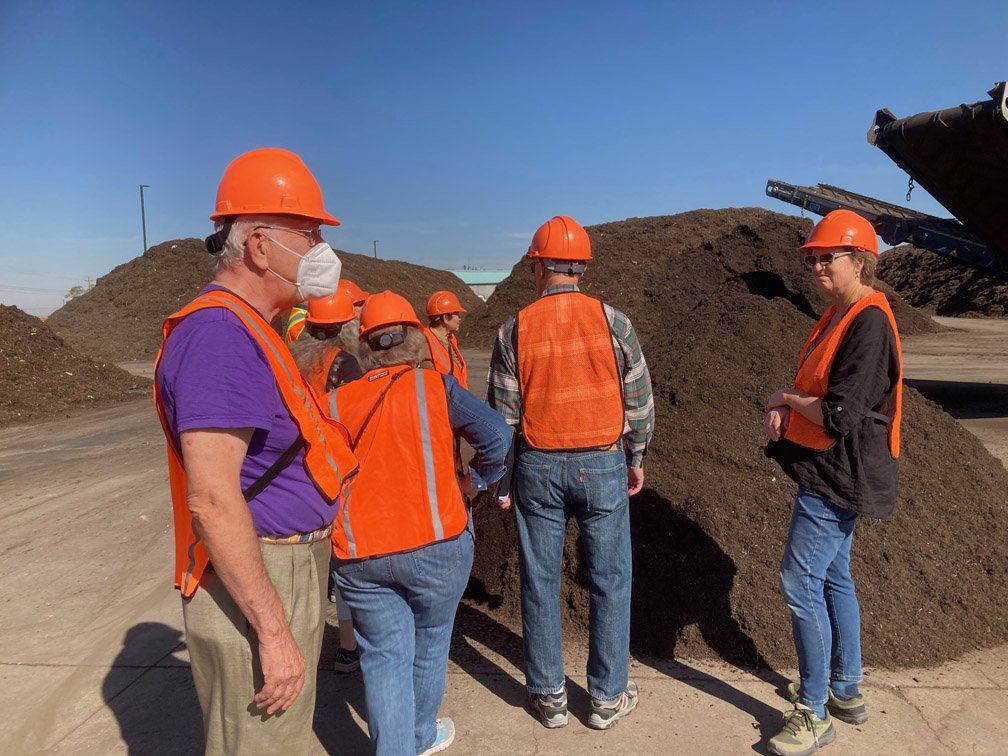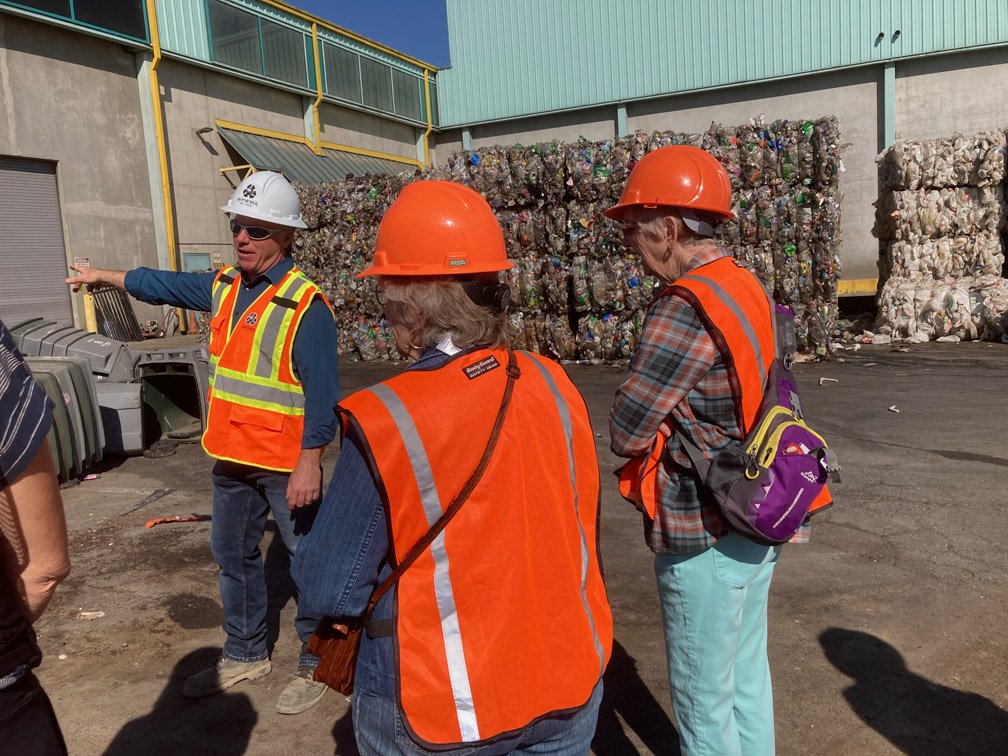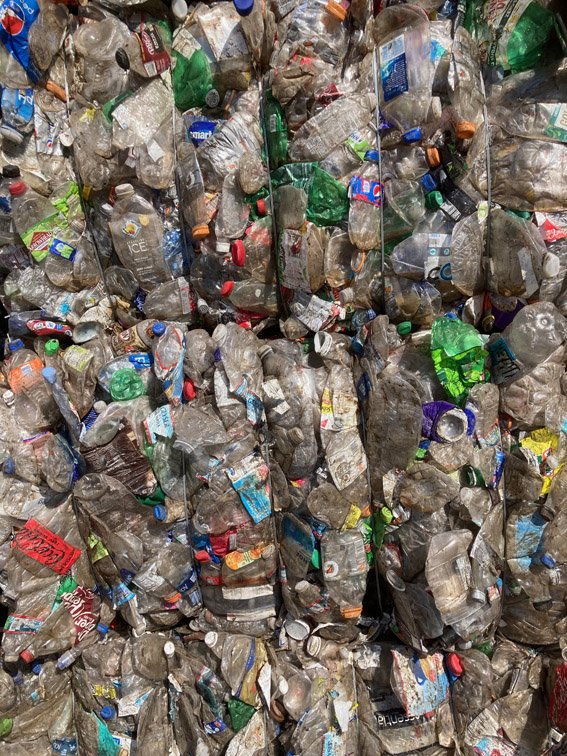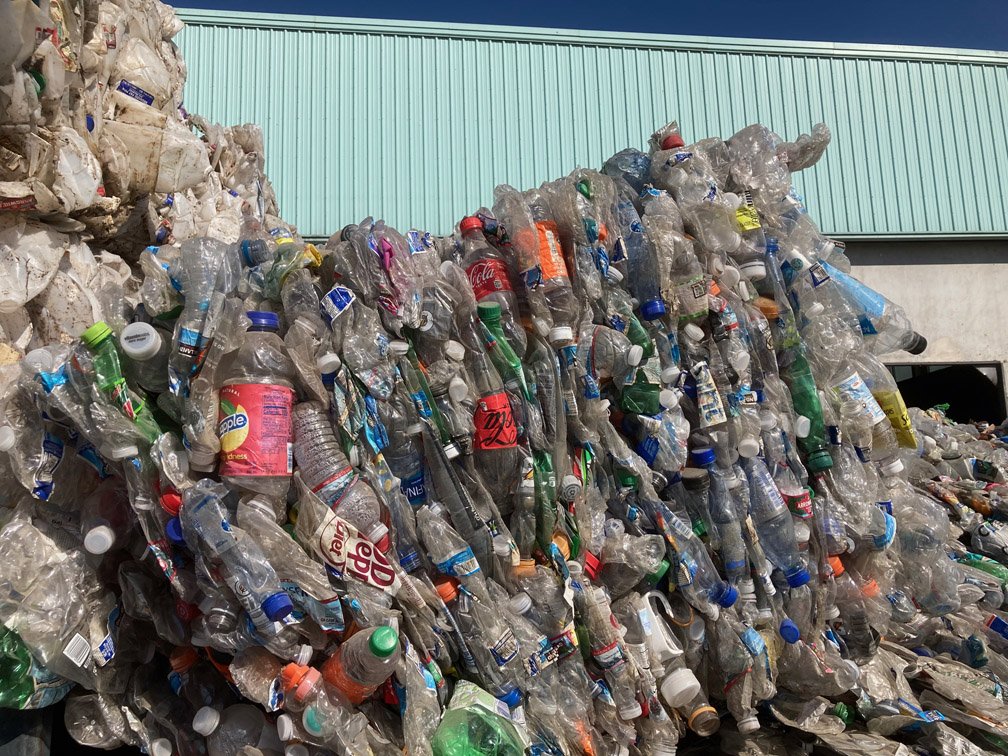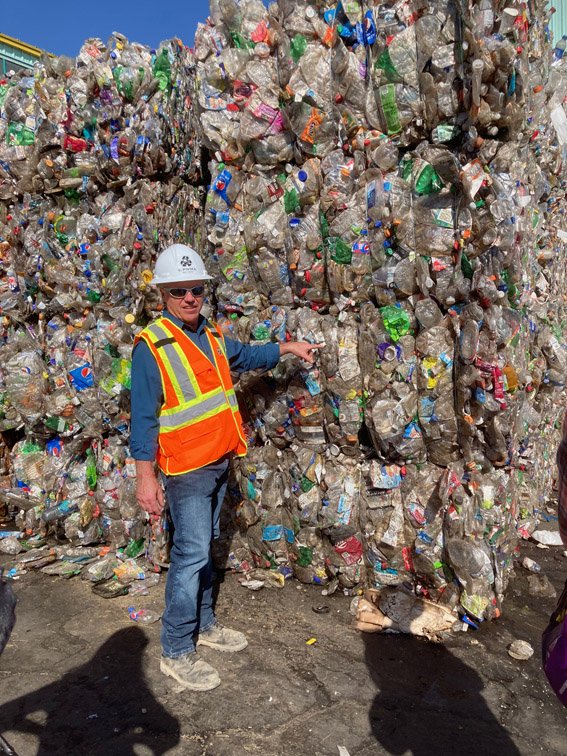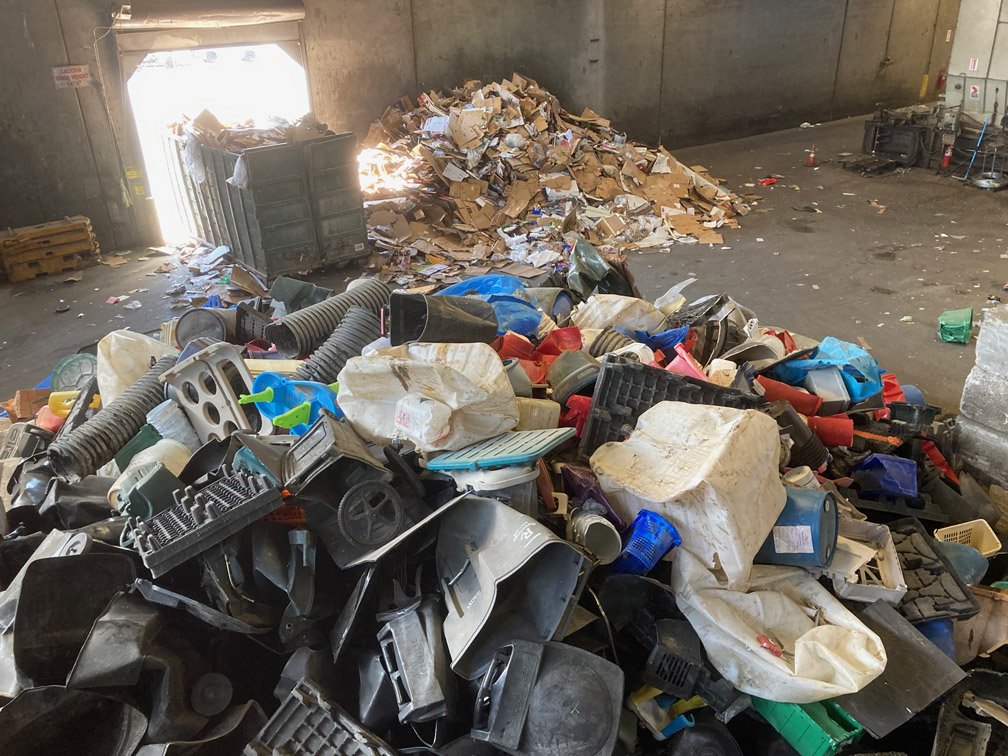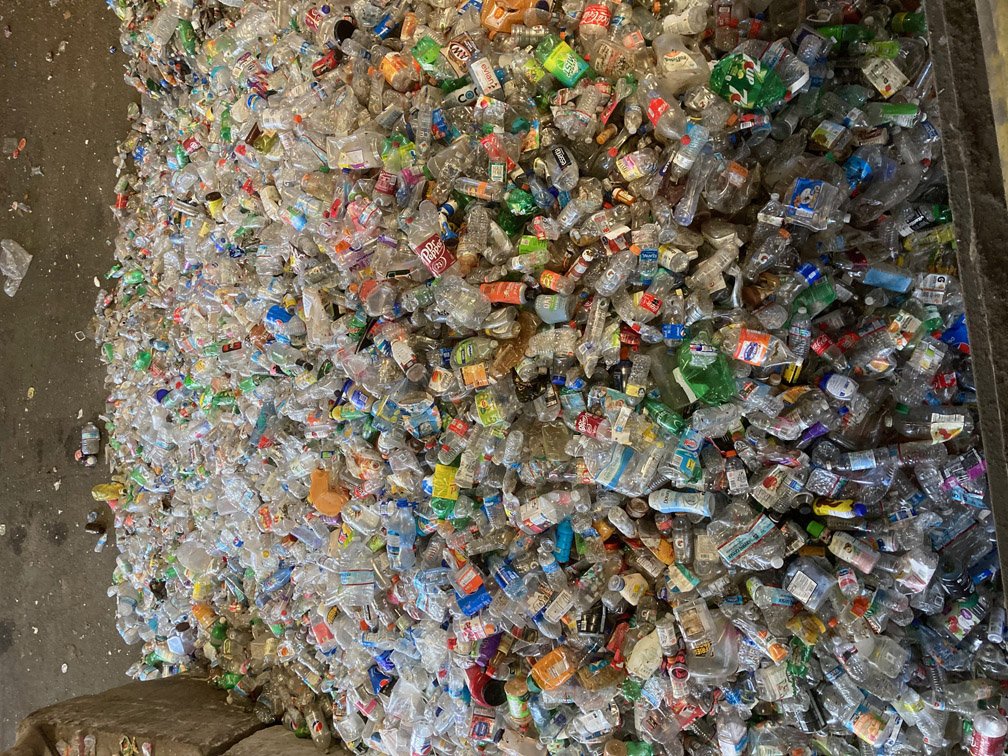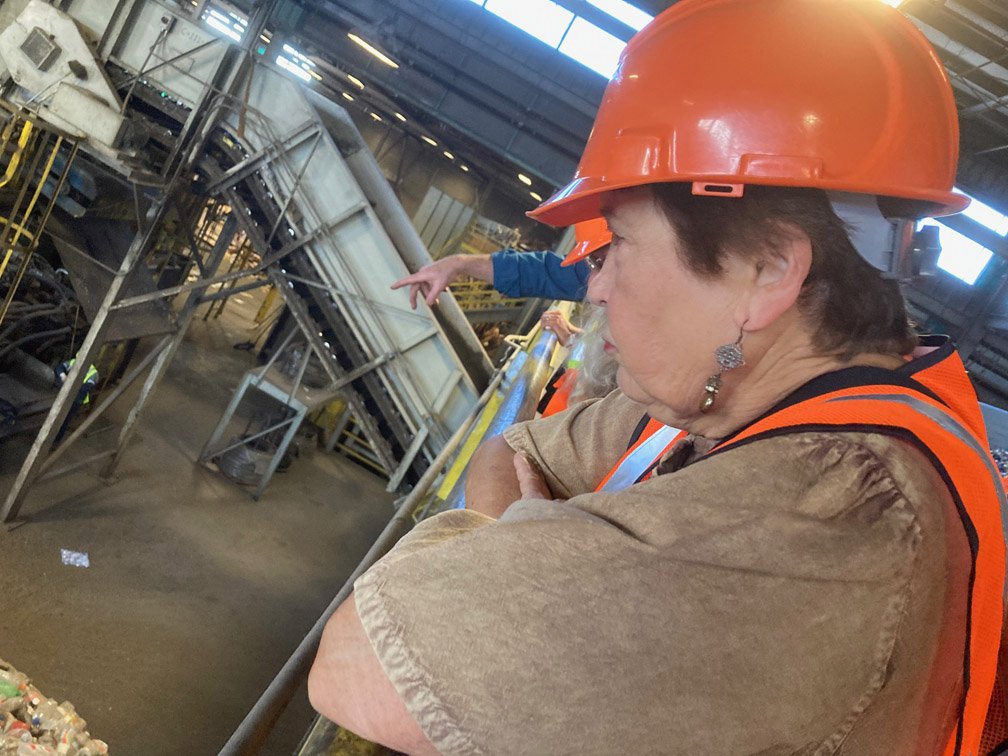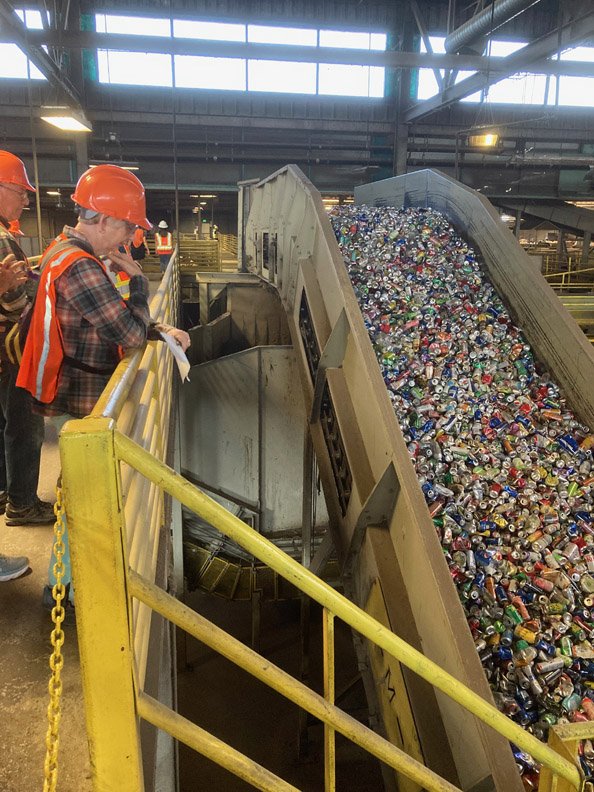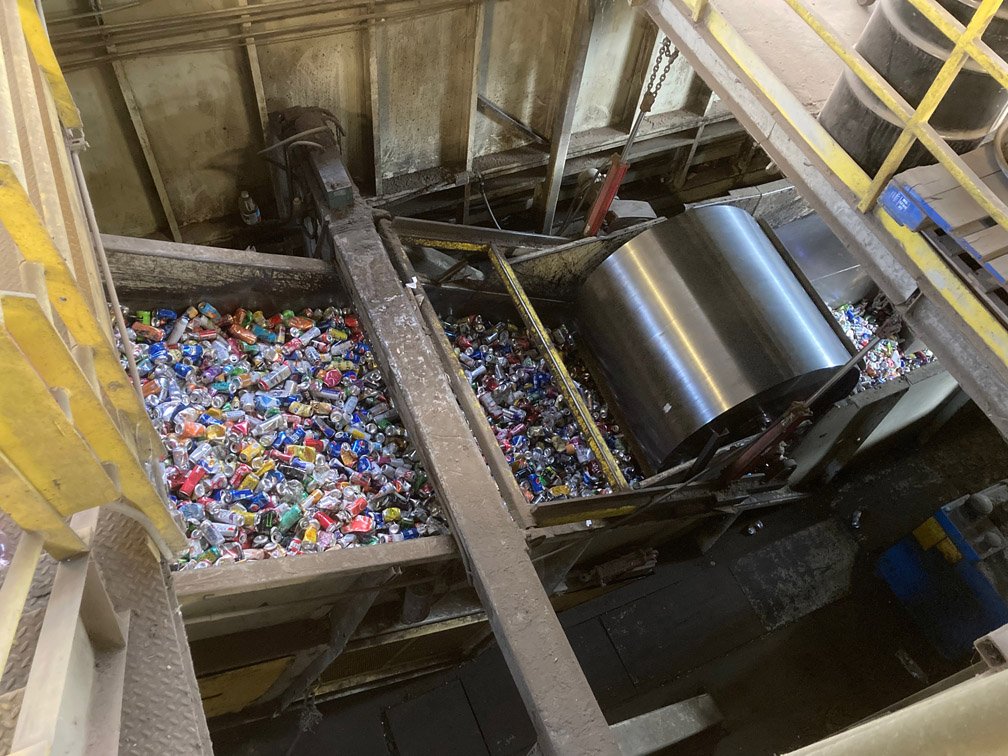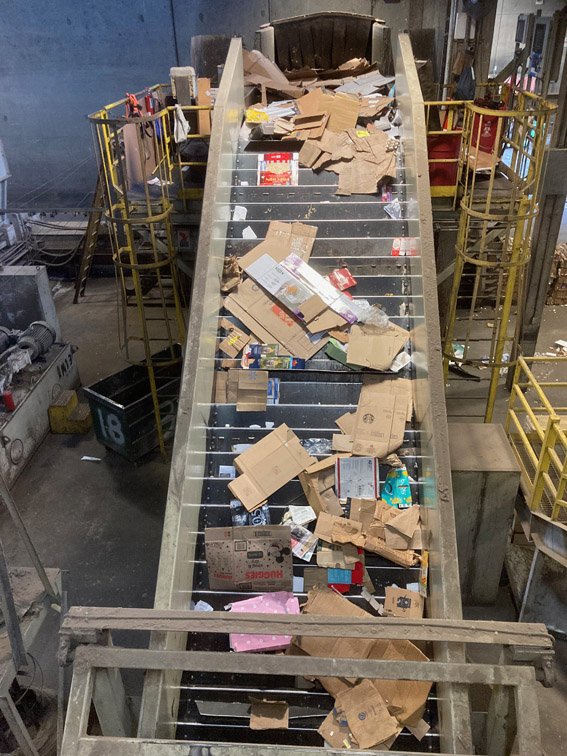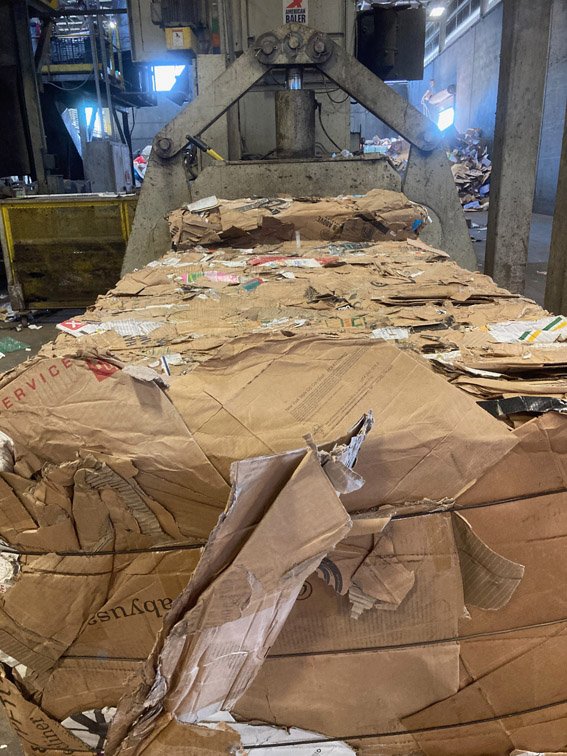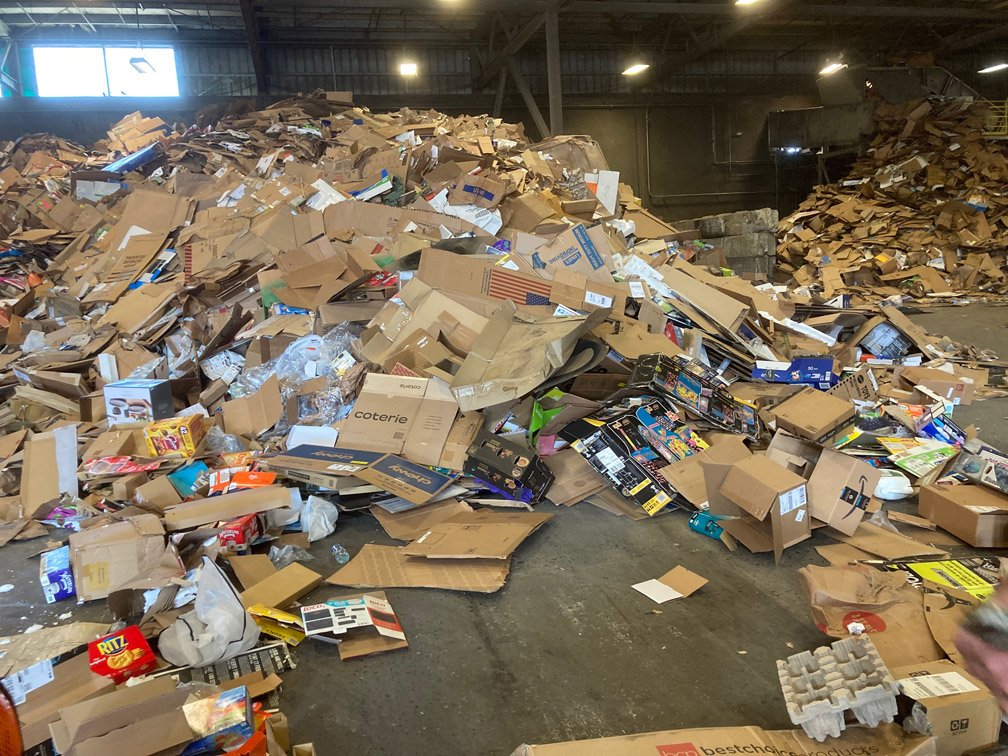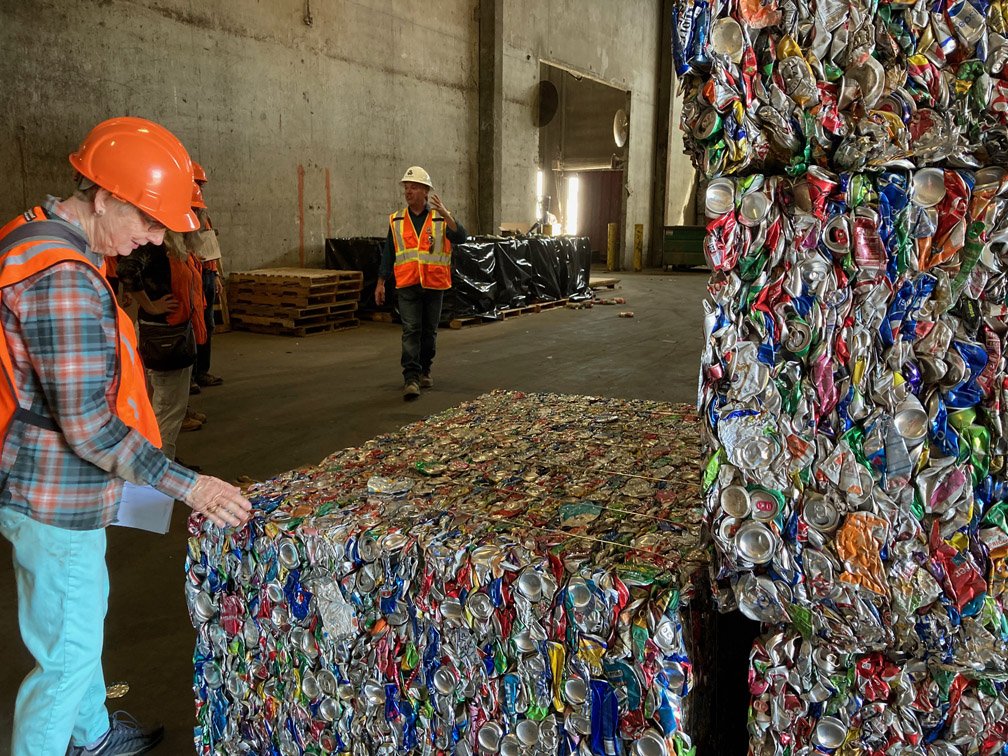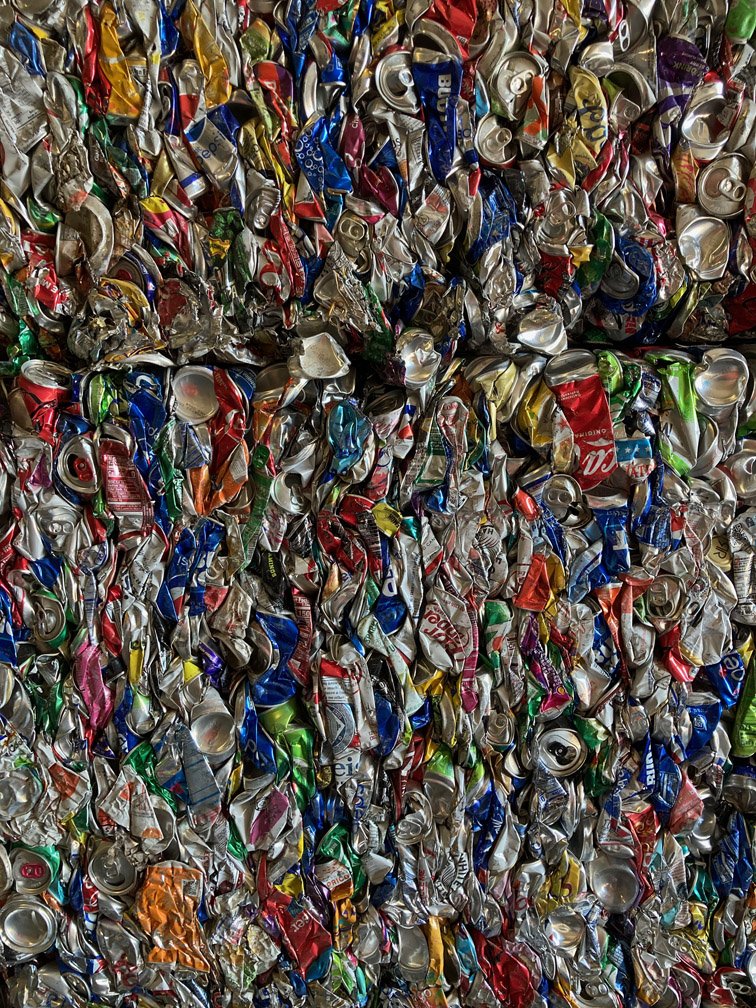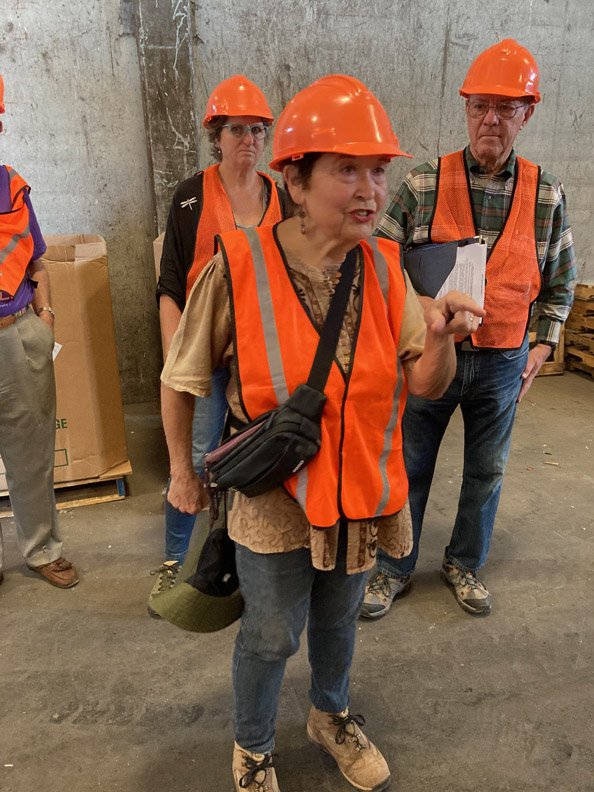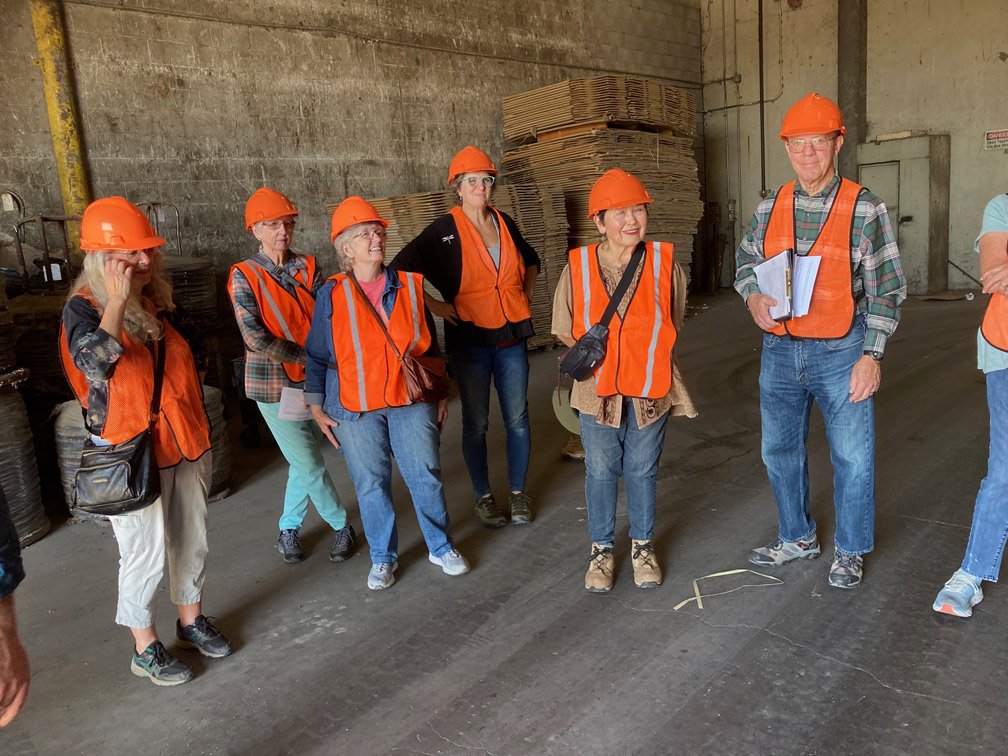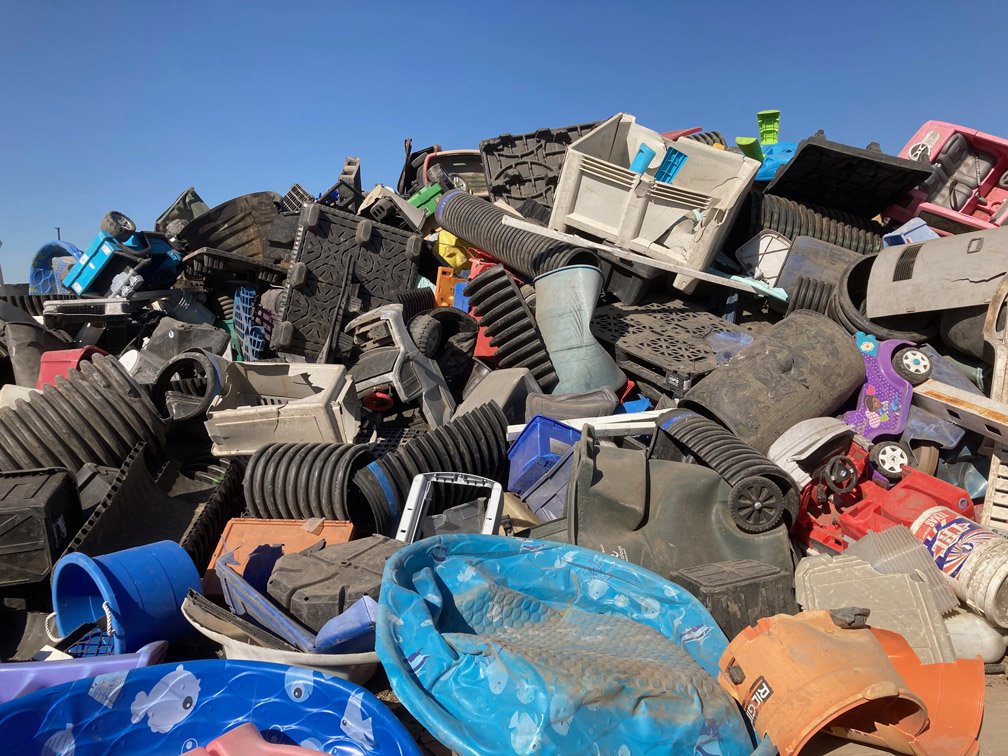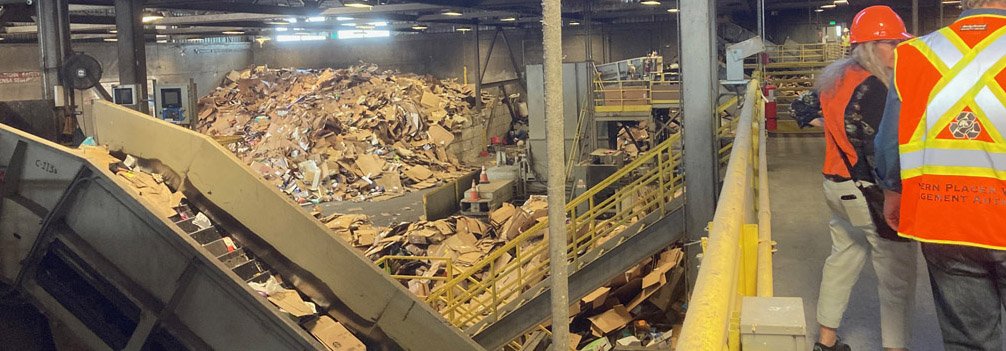Do You Wonder What Happens to Your Trash? We Did!
Touring WPWMA’s Materials Recovery Facility
Members of PPoFT’s Plastic/Climate Action Group all tricked out for the Materials Recovery Facility tour on Oct 11, 2022.
Members of Placer People of Faith Together’s Plastic/Climate Action group took a tour of the Western Placer Waste Management Authority's (WPWMA) Materials Recovery Facilty (MRF) on October 11, 2022. The WPWMA is a regional agency serving western Placer County and consists of the Western Regional Sanitary Landfill and the MRF, located at the corner of Fiddyment Rd. and Athens Ave. in Roseville. The landfill began operation in 1979 and currently is permitted to receive waste through 2058. A primary function of the MRF is to divert useable material from the landfill, which starts with Placer County’s One Big Bin program.
Quick Links to this Information on this Page:
Repurposed Material Diverted from the Landfill
One Big Bin
In 1989 California passed The Integrated Waste Management Act (AB 939), which requires that 50% of the waste accepted by municipalities be diverted from landfills (through source reduction, recycling, and composting). Placer County (and the WPWMA) responded by instituting the One Big Bin program. Users throw all of their waste into one big bin (including recyclables and food waste), rather than separating material for curbside collection. The only waste that households are asked to keep separate is household hazardous waste, such as batteries, used motor oil, FOG (fats oils and grease), medications, paint, aerosol cans, and the like.
Part of the reason that the WPWMA chose to go with One Big Bin is because at the time Placer County was more rural, so sending trash trucks on multiple long runs to pick up separated materials would have been too costly and time-consuming (and all that extra driving contributes greenhouse gases to the atmosphere). In addition, the county wanted to make waste recovery less burdensome for businesses. Thus, Placer County created a mixed waste processing model (or “dirty MRF”) that would NOT require sorting by its users (businesses and households). Users throw all waste into their One Big Bin, which is collected and brought to the MRF. Once at the MRF, the waste is loaded onto conveyor belts and sorted by hand into trash destined for the landfill and material that can be economically diverted, such as green waste, organics, glass, aluminum cans, metal, paper, cardboard, and plastics. Although some would think that the One Big Bin program would result in lower rates of recycling, we learned that approximately 60-70% of the waste waste Placer County residents dispose of does find new purpose (recyclables and compost) and is diverted from the landfill. The convenience of One Big Bin essentially ensures 100% participation by its users. On the other hand, consumers who do not sort their trash tend to bear less personal responsibility for what happens to their waste once they toss it, and often are less aware of the environmental harm caused by their consumer habits.
Unfortunately, last Fall (2021) a fire knocked out a large portion of the MRF, including two of the conveyor belts. Sorting continues, but much less is being sorted and diverted than before the fire. That diversion rate was temporarily lower (a minimum of 8%) while the MRF was being repaired. As of December 1, the MRF repairs have been finished and the normal diversion of a minimum of 22% is back in effect.
To get an overview of how the MRF operates, click on the video below.
To learn more about the Materials Recovery Facility, visit https://placerrecycles.com/
Our Quick Take Aways
If you don’t have the time or inclination to read any further, here is a quick list of our “take home points” from the excellent tour that we were given at the MRF:
Eric Oddo (Program Manager for the Western Placer Waste Management Authority) was extremely informative and fielded our many questions.
Put the caps back on your plastic bottles before tossing into your one big bin.
There is no need to wash your bottles and cans, nor do you need to remove the labels.
There is no market for plastic clam shell containers (like for strawberries); these go to the landfill.
All plastic bags are ripped open in order to sort the waste, and the bags are sent to the landfill. So if possible, minimize your use of plastic trash bags.
Cereal boxes, and the like, are sorted into the mixed paper pile (and is not the same as corrugated cardboard).
Paper milk cartons are NOT recyclable because they are coated with plastic (all cartons end up in the landfill). So, it is best to buy milk in plastic jugs or glass jars, because these do have a market for recycling.
Compostable plastic takes years to break down and can not be put in the compost at the MRF (not approved by OMRI, the Organic Materials Review Institute).
Drop off stretch plastic bags and films at participating retailers instead of sending to the MRF (they get tangled in the sorting machinery).
No polystyrene (such as products made with styrofoam) is recyclable.
Aerosol cans AND cooking fat, oil, and grease (FOG) are actually considered household hazardous waste and should not be placed in your one big bin (rather dispose of them with your other household hazardous waste during drop off or pick up days).
No waste taken to the WPWMA is incinerated - it is either put in the landfill, or diverted through recycling/repurposing or composted.
New Operator for the MRF
Two conveyor belts currently out of commission due to the recent fire at the MRF. These and others in the MRF building will be replaced with an upgraded system that adds a significant amount of screening up front prior to being hand-sorted. Upgrades to the whole WPWMA system are being done in stages with completion expected by February 2025.
FCC Environmental Services took over operations at the MRF in July (2022), and the facility is being expanded and upgraded with new equipment. The new equipment will better accommodate the sorting process and will aid in complying with the new California law regarding organic waste (SB 1383, effective January 2022). SB 1383 requires diverting at least 75% of organic materials (especially food scraps) by 2025 in order to reduce the amount of methane produced in CA landfills.
The repairs to the fire-damaged portions of the MRF were completed at the end of November (2022). So, the MRF is back to running at full capacity with the old equipment (diverting a minimum of 22% of the materials away from the landfill). The upgraded new equipment is expected to be assembled by February of 2025. Once upgraded, the MRF will divert more than 60% of the waste it receives! FCC is optimistic that their designs will hit even higher diversion rates than those. Our group certainly will be coming back to see the new operation in action!
Repurposed Material Diverted from the Landfill
In order to repurpose waste received by the WPWMA, someone must be willing to buy it. Currently, there are successful markets for aluminum, copper, metals, mixed glass, corrugated cardboard, paper, and some plastics.
Plastics
#1 plastic beverage containers, bound for recycling at the MRF - note that the caps are still on the bottles.
#2 plastics at the MRF, bound for recycling at the MRF - note that the caps are still on the bottles.
Although plastics come with a running arrows numbering system (1-7), not all plastic has a viable market. So, even if your plastic has a number on it, it doesn’t mean that it can be recycled. In particular, there are no markets for styrofoam, chip and snack bags, and plastic wrappers. Although markets are changeable, currently (October 2022) the MRF has found markets for:
Some #1 plastics (polyethylene terephthalate or PET). Most of the California Redemption Value (CRV) plastic beverage containers are #1 plastics, and are recyclable. Unfortunately, there is no market for the #1 plastic clamshell containers commonly used for products such as strawberries and blueberries. Collected #1 plastics can be recycled into new beverage containers, or downcycled into textiles, fleece jackets, carpets, stuffing, storage containers, boat sails, shoes, and autoparts. When you put plastic bottles in your one big bin, leave the tops on. This prevents the small caps, usually made of #2 and #5 plastics, from slipping through screens and ending up with the glass or in waste bound for the landfill. During reprocessing, plastic bottles with their caps are shredded and then the caps are easily separated from the bottle plastic through flotation (the shredded caps float whereas the shredded bottle pieces sink). Once separate, the plastic from the caps can be repurposed as well.
Some #2 plastics (high-density polyethylene, or HDPE). This plastic includes water jugs and milk jugs. Recycled #2 plastics can be downcycled into plastic crates, lumber, decking, and fencing, furniture, piping, floor tiles, buckets and crates, flowerpots and garden edging, rubbish bins, compost bins, recycling bins, and children’s toys. As with the #1 bottles, leave the caps on the #2 bottles so that the caps can be captured along with the bottles, then separated, and recycled. Those of you who buy milk in paper cartons, be aware that milk cartons are coated in plastic and, thus, are not recyclable. So, if you are looking to keep waste out of the landfill either buy milk in #2 plastic jugs or in glass containers.
A mountain of mixed rigid plastic at the MRF, bound for recycling.
A variety of mixed rigid plastics. The MRF recently found a market for mixed rigid plastics, and these are now being sorted and shipped out to the purchaser.
What About Plastic Bags?
The first thing that a hand-sorter does at the MRF is rip open the plastic garbage bags we set at the curb and empty the contents onto the conveyor belt, discarding the bag. Plastic bags and other loose filmy plastics are a hazard at the MRF because they can get tangled in the machinery during the sorting process. Rather than putting your plastic bags and films in the trash, it is best to save them to drop off elsewhere. There is a market for clean and dry generally translucent, soft and stretchy plastic bags, films, or packaging material (often with #2 or #4 labels) through participating retailers and local drop-off locations. Also, local food banks reuse shopping bags and bread bags to package goods for their clients. Click here for stores in the greater Auburn area that accept bags and films for recycling.
Glass
Unlike plastic, glass is 100% recyclable without losing quality or purity. In Placer County, there is no need to separate your glass by color, remove labels, or even clean your bottles before tossing it into your trash can. The MRF sells mixed glass (all colors co-mingled, labels on, unwashed) to Strategic Materials, Inc. Strategic Materials, Inc. processes the mixed glass into smaller particles of glass (called cullet) by washing, grinding, sieving, drying, blowing (to remove the labels), and passing through an optical scanner (to sort by color). The video below shows how all of this is accomplished. Strategic Materials currently has two markets for their processed glass: new glass bottles and fiberglass insulation.
An example of a load of mixed glass bound for recycling. Although it looks ‘dirty’, the buyer is more interested in getting a consistent product each time they purchase a load from the MRF.
Watch this video to see how mixed glass gets processed for reuse.
Aluminum Cans and Other Metal
The aluminum cans that you toss into your one big bin are by far the biggest money-maker for the MRF - worth about $6000 per ton at the time of our tour (October 2022). Workers and machinery at the MRF sort aluminum from the waste stream where it is conveyed to a compactor, and compacted into one ton cubes.
Aluminum cans sorted and headed to the compactor.
Cans compacted into approximately one ton cubes ready to be collected for recycling.
Other metals such as ferrous metals like steel (sorted using magnets) and copper are removed from the waste stream and sold as scrap metal.
Metals diverted from the waste stream await recycling.
Copper diverted from the waste stream ready for a new life.
What About Aerosol Cans?
Aerosol containers, whether plastic or metal, are considered to be household hazardous waste, and should not be thrown into your one big bin. If it does enter the waste stream, the workers must pull it out and off of their machinery. This includes seemingly innocuous products like cooking spray and whipped cream along with the more obvious products such as spray paints, pesticides, and cleaning products. The EPA has classified aerosols as universal waste (a subset of hazardous waste) meaning that they are hazardous upon disposal but pose a lower risk to people and the environment than other hazardous wastes. The risk is two-fold: (1) because aerosol cans are pressurized, they may explode when crushed during the sorting or baling process, and (2) the propellant may be ignitable or toxic, and the product itself may be ignitable, corrosive, or toxic. Thus, even if an aerosol can appears to be empty, it still must be separated for safety purposes. Most aerosol cans use hydrocarbons, such as propane, butane, or LPG gas as the propellant, which are ignitable. If you were wondering, whipped cream uses nitrous oxide as a propellant (thus, if not emptied, the can could explode if crushed) and cooking spray commonly uses butane, isobutane, and propane.
Aerosol cans are treated as household hazardous waste, and must be separated in order to remove the propellant they contain. Even if you think it is empty when you toss it, there is usually still some propellant remaining in the can.
If aerosol cans make their way into the waste stream, then the sorters at the MRF must remove them. Once collected, they are sent off property to a company that specializes in removing the propellants. The cost to the MRF for this service is approximately $0.50 per can. Proper disposal of aerosols is expensive, but the potential threats to the environment and the MRF are greater. Definition and disposal of aerosols and universal waste is governed by the California Code of Regulations (Title 22, Chapter 23) and the Health and Safety Code (section 25202.16).
Cardboard
Corrugated cardboard is separated onto conveyor belts and collected in one place in the MRF to be compacted for reuse.
Old cardboard can be recycled into new cardboard, which incidentally requires 25% less energy than making new cardboard. At the MRF, corrugated cardboard is sorted into piles, flattened, and baled. Recyclers will then ship the bales to a pulper or papermill to be reprocessed into new cardboard boxes or paper. Click here for a pdf explaining how corrugated cardboard is recycled for reuse.
Flattened and baled corrugated cardboard at the MRF
Watch this video to learn how cardboard is recycled to make paper.
Mixed paper
Mixed paper awaits repurposing.
Mixed paper includes office paper, newspaper, magazines, discarded mail, and non-corrugated cardboard (like cereal boxes and egg cartons). Mixed paper may be shipped to a paper mill and repurposed to make fiber for new paper. According to the American Forest and Paper Association, the paper recycling rate in 2021 was 68%. So, the paper we toss into our one big bin will likely find new life as recycled paper (defined as paper that contains a minimum of 60% post-consumer waste).
Watch this video to see how mixed paper and cardboard is turned into new cereal boxes.
Organics - Composting!
A sizeable area of the WPWMA facility is set aside for composting. In order to be marketable, all compost made at the MRF is prepared according to the standards of the Organic Materials Review Institute (OMRI-certified). Because it is OMRI-certified, no compostable plastic is allowed in the compost created at the MRF.
Here we are walking toward windrows of composting mulched green waste.
Two types of composting windrows are created at the MRF: those that consist of mulched green waste (grass clippings, leaves, tree residue) and those that are created by mixing organics (food scraps) with mulched green waste.
Long composting windrows are watered regularly and sit for approximately 8 weeks. The windrows that contain organic matter also are aerated (to prevent production of methane gas) using pvc piping attached to blowers.
An aeration system used for composting windrows that include organics such as food scraps.
Once finished, the windrows are sieved and the resultant organic-rich soil is sold as OMRI-certified compost to the public. When FCC took over operation of the MRF, the old compost was removed, and new composting windrows were created. Once construction at the MRF is complete, then compost will be available to the public for purchase.
Windrows are eventually sieved to make usable compost.
Examining the final compost product at the MRF.
California’s New Organic Waste Recycling Law
Composting at the WPWMA. A longer version of this video is available by clicking here.
The new California state law governing organic waste (SB 1383) requires diverting at least 75% of organic materials (food scraps, leaves, lawn clippings, soiled paper products) from the waste stream by 2025. Why this law? When organic waste ends up buried in the landfill, anaerobic bacteria will digest the waste and release methane, which is a powerful greenhouse gas. So, diverting organic waste from the landfill is just one way that California is following through on its pledge to reduce greenhouse gas emissions
In general, this new law will not change anything for users in Placer County - just toss the organics into your one big bin and it will be sorted with everything else at the MRF. Once will removed from residential and commercial waste streams it will be composted (or otherwise recycled).
In January 2024, we had some follow up questions for the MRF, this is what we learned from the Public Information Assistant at the WPWMA.
Can coffee grounds, vegetable scraps and banana peels (e.g.) go in the green waste bins? This depends on your garbage hauler. Many haulers do not want residents putting food scraps in their green waste bins as it can cause pest, odor, and cleanliness issues with bins and garbage trucks. Reach out to your garbage hauler to find out if this is acceptable.
If not, what happens to them now and how will they be handled with the new system? When any material comes into the new MRF, everything will be size reduced to rip open bags and free materials from any packaging. Materials that are smaller than 2 inches (which contains the vast majority of organic waste) will be sorted using screens to remove non-organic materials. Then, this organic rich material will be placed on a covered conveyor belt and sent directly to be composted using Covered Aerated Static Pile composting. After the compost has reached maturation, the material will be screened again to shred larger pieces of compost and screen out residual non-organic materials for a final time.
If residents put vegetable and fruit waste in their green bins, is it more likely that they will be composted rather than ending up in the landfill? There is an equally likely chance those items will be composted regardless of which bin they are placed in, if a hauler allows residents to place food waste in their green waste bin.
Electricity from Landfill Gas
The WPWMA delivers landfill gas to Energy 2001, a private company that leases approximately 15,000 square feet at the WPWMA for its power plant. Methane gas created within the landfill itself is tapped by Energy 2001 to generate enough electricity to power more than 3000 homes and businesses annually. A portion of the profits from this operation is returned to the WPWMA.
This aerial photograph of the WPWMA, shows the portion that it is currently active (outlined in red). The surrounding areas in the photograph currently are leased out for other purposes. The black arrow shows the location of Energy 2001’s onsite power plant.
An interactive on-line map overview of this area also is available on the renewable placer web site.
Can They Divert Trash to Incinerators?
No waste brought to the WPWMA is incinerated. However, The Integrated Waste Management Act (AB 939) did permit jurisdictions to count a “diversion credit” of up to 10% for waste sent to municipal solid waste incinerators. There are only two municipal solid waste incinerators still operating in California, both in southern California and out of reach for Placer County. Incinerators, such as Long Beach’s Southeast Resource Recovery Facility (SERRF), present a health risk to the usually low income neighborhoods where they inevitably are located. The passage of AB 1857 last September (2022) corrected this environmental justice issue by repealing the original provision in AB 939 that authorized the inclusion of not more than 10% of the diversion through ‘transformation’ (i.e. incineration). Click below for more information about AB 939:
The Story of California’s Two Incinerators - October 26, 2022 from Waste 360
AB1857 (C. Garcia) - from Californians Against Waste
Watch this video to learn more about how to recognize household hazardous waste and how to responsibly dispose of it.
Household Hazardous Waste
Household hazardous waste, such as e-waste, motor oil, cooking fats, oil and grease (FOG), aerosol cans, medications, lightbulbs, oil-based paints, pain thinner, and household chemicals require specialized handling and should not be placed in your One Big Bin. The WPWMA offers free drop off of household hazardous waste, and some jurisdictions even have curbside pick up by appointment.
WPWMA’s Plan for the Future
The WPWMA is currently undergoing a $120 million site-wide facility improvement project, completely renovating several facilities of the WPWMA’s campus including the Materials Recovery Facility, the Construction & Demolition facility, and composting facilities.
Future plans for the WPWMA include:
upgrading the MRF to expand its capacity for recycling, composting, and recovering construction and demolition materials,
expanding the landfill area over time, and
using surrounding land for an industrial park and a research center in conjunction with Sac State and others to test new technologies for waste recycling and creating beneficial products from material diverted from the waste stream.
This will be essential, as Placer County is expecting its population (especially in West Count/Roseville/Lincoln) to double. Click here for the WPWMA’s Waste Action Plan flyer, and here for the WPWMA’s Final Environmental Impact Report. You can also go to the renewable placer web site and choose ‘2050’ in the side bar to see two different plans (concept 1 and concept 2) for the WPWMA.
More Photos from our Tour
Our thanks to Eric Oddo (Program Manager for the Western Placer Waste Management Authority) and Emily Hoffman (WPWMA’s Public Information Assistant) for showing us what happens at the MRF and answering our many questions.
